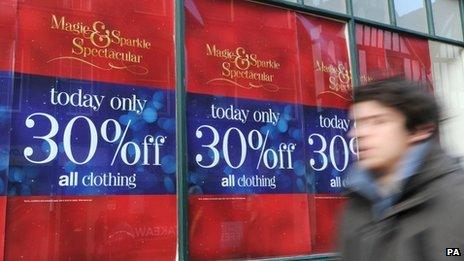Whose fault is M&S's stagnation?
- Published
- comments

M&S started its sales ahead of New Year
It is a bit of a cliche (sorry) but the story of retailing over the past six months has in part been the story of the weather.
In the balmy summer, we all went shopping barmy. "Everyone bought expensive food for picnics and bikinis" as one retailing supremo put it to me (I am not sure I did, but I am probably the exception).
Then we worried in the autumn that we had overdone the spending. And there was a warm spell in October, which meant we didn't need winter coats. We tightened our belts - worn over unseasonal t-shirts - again.
From November on, we started spending with renewed vigour, especially on what the analysts call "bigger ticket" items (tablets, TVs and so on) and DIY.
Storm damage
But in the couple of weeks before Christmas, we did not go bonkers on clothing, in spite of huge discounts being offered. And the storms apparently stopped many of us going into the stores on Boxing day.
As for the economics behind all this, there are a lot more people in work, and consumers seem to believe the Bank of England that interest rates are staying low.
So for those working for the first time in ages, there's a bit more money available. And in general households are saving less and spending more, even though their disposable incomes are still squeezed (and see my blog from earlier today).
Also, there's that humungous industrial trend of online shopping continuing to grow like the clappers, while the High Street treads water (at best).
When you put all that together, it means that the giant retailers we used to think of as bellwethers for the economy are anything but bellwethers. I am thinking of Tesco (of which more before long) and that ghost of Christmases past, Marks & Spencer.
M&S disappoints
What of Christmas present? Well it is pretty clear Marks & Spencer has performed much worse than investors were hoping and expecting.
The recent fall in its share price implies underlying or like-for-like sales of clothes and general merchandise in recent weeks have dropped at least 1.5%, compared with analysts' forecasts of just a modest drop.
Meanwhile profitability has been marred by the rampant discounting - including its own - that took place in the fortnight before Christmas.
Is it that M&S's kit is still not what the punters want?
Possibly.
Bolland has a year
However my understanding is that M&S's board is giving the chief executive Marc Bolland the benefit of the doubt - which is another way of saying that he has another year to sort this out.
Perhaps the biggest structural weakness of M&S relative to that long-running thorn in its side, Next, is M&S's much smaller online business.
When I first started writing about Next as a new challenger to M&S in 1985 (I was a cub reporter probably wearing Next shorts), I did anticipate that one day Next would be the daddy (monkeys and typewriters, perhaps).
But it still comes as a shock that Next's market value today is 30% greater than Marks's and that it is on course to make bigger profits than its lumbering and venerable rival.
One interesting question is the extent to which Next benefits from its expertise - built up from its strong position in online and home shopping - in selling on credit.
If we are more minded (perhaps unwisely) to borrow to buy again, those companies with a history in home shopping, more confident about making rapid credit assessments (like Next, not like M&S) would tend to be beneficiaries, at least in the shorter term.